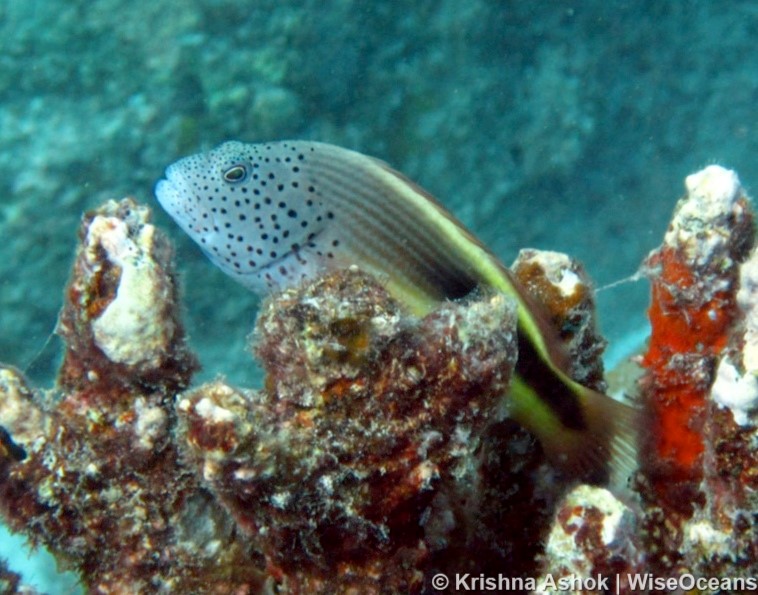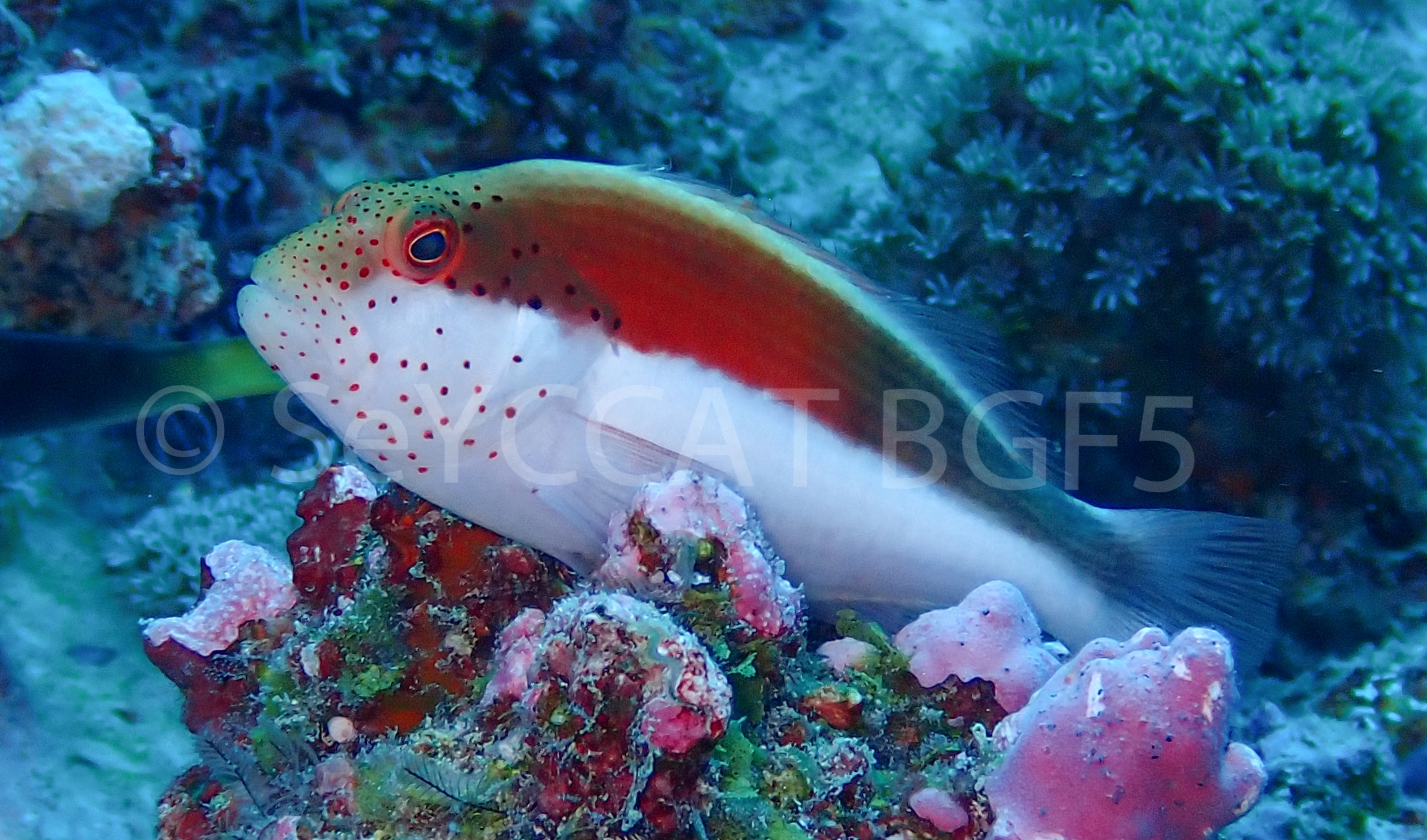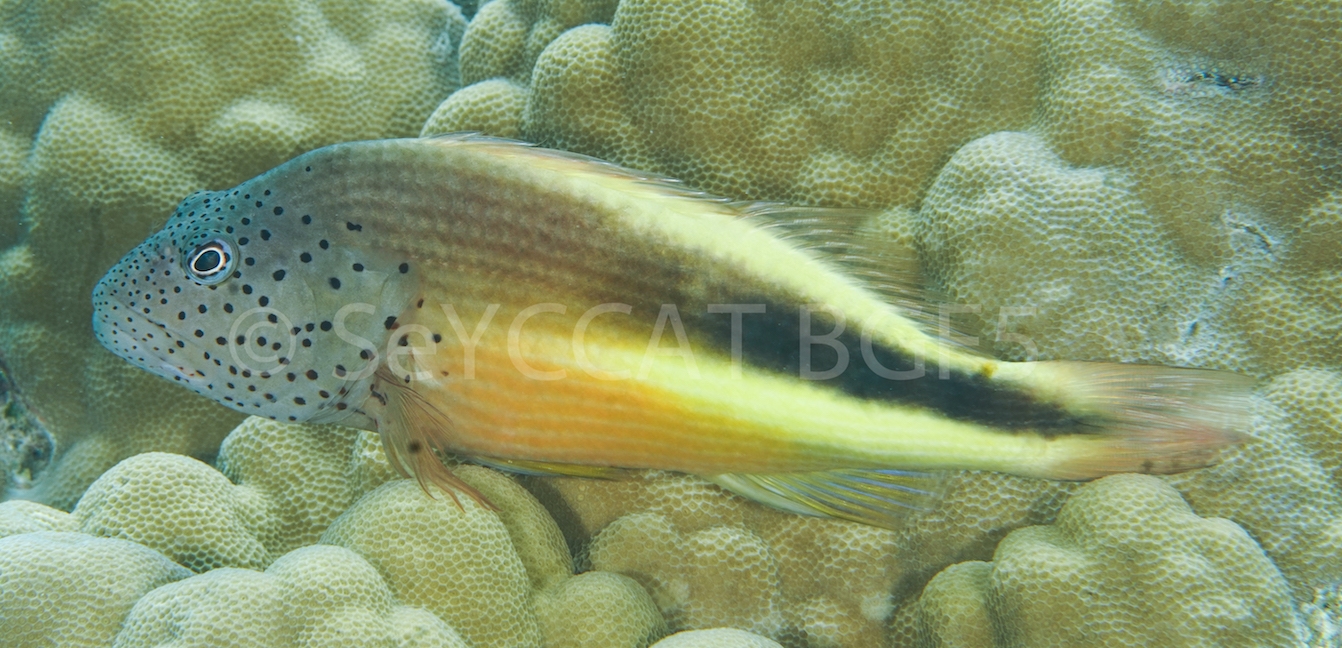Description:
Dorsal spines: 10; Dorsal rays: 11; Anal spines: 3; Anal rays: 6.
Moderately full-bodied Hawkfish. Snout short. Mouth large, the maxilla reaching posterior to a vertical at centre of eye. Continuous dorsal fin, notched between spinous and
soft portions. Caudal fin slightly rounded.
Colour. Body yellowish with broad blackish band on upper flank. Head and anterior part of body with small dark reddish spots. Colour changes with growth as well as varies
among adults. Fins varying from yellowish to pink. Juveniles may be red dorsally. The red and yellow phase was initially described as a distinct species.
Size:
Maturity: Lm unknown. Range unknown. Max Length: 22cm TL, commonly to 18cm TL.
Habitat and Ecology:
Inhabits clear lagoon or seaward reefs (depth 1-35m). Occurs openly on coral and soft-bottom habitats, often observed sitting on live coral (typically of Stylophora,
Pocillopora, and Acropora). Feeds mainly on small fishes and crustaceans. Kadota & Sakai (2016) studied its breeding behaviour and found: large males maintained territories
and defended them against other large males. Females usually stayed outside of male territories during the day and moved to prominent coral heads within male territories
during the late afternoon for mating. Large males spawned with several females around sunset, and females seldom changed their mating partners. Small males placed their
territories against other small males within/around the territories of large males and pair-spawned with small females.
Fishery Status:
This species is not protected or subject to fishery regulations. It is has not been observed in the fishery catch, but elsewhere is reported to occasionally be caught on
hook and line.
Notes:
Photo. courtesy and (c) 2020 Krishna Ashok.
Photos courtesy Eleanor Brighton and Chris Mason-Parker (c) 2022 Blue Safari Seychelles/Marine Conservation Society, Seychelles. Photograph taken at Alphonse group 2022.
References:
Fischer, W. & G. Bianchi (eds), (1984). FAO species identification sheets for fishery purposes. Western Indian Ocean; (Fishing Area 51). Prepared and printed with the
support of the Danish International Development Agency (DANIDA). Rome, Food and Agricultural Organization of the United Nations, vols 1-6.
Froese, R. & D. Pauly. (Eds.) (2020). FishBase. https://www.fishbase.se/summary/Paracirrhites-forsteri (28/04/20).
Greenfield, D. & Williams, I. (2016). Paracirrhites forsteri (errata version 2017). The IUCN Red List 2016: https://dx.doi.org/10.2305/IUCN.UK.2016-1.RLTS.T67997879A68001726.en. (28/04/20).
Kadota, T. & Sakai, Y. (2016). Mating system of the freckled hawkfish, Paracirrhites forsteri (Cirrhitidae) on Kuchierabu-jima Island reefs, southern Japan. Environmental
Biology of Fishes 99, 761-769 (2016).
Citation:
Nevill, J.E.G. (2020). Paracirrhites forsteri, Blackside hawkfish. Seychelles Seatizens. www.seatizens.sc. https://seatizens.sc/species/paracirrhites-forsteri-schneider-1801/ (updated 17/07/22).




pin-up 306: pin up apk yukle – pin up kazino
buying from online mexican pharmacy mexican pharmacy northern doctors mexico pharmacies prescription drugs
http://northern-doctors.org/# pharmacies in mexico that ship to usa
https://northern-doctors.org/# mexican rx online
buying prescription drugs in mexico mexican pharmacy pharmacies in mexico that ship to usa
https://northern-doctors.org/# mexico drug stores pharmacies
https://northern-doctors.org/# buying prescription drugs in mexico
http://northern-doctors.org/# pharmacies in mexico that ship to usa
mexico drug stores pharmacies Mexico pharmacy that ship to usa mexico drug stores pharmacies
http://northern-doctors.org/# mexican pharmaceuticals online
purple pharmacy mexico price list mexican online pharmacies prescription drugs buying prescription drugs in mexico online
https://northern-doctors.org/# mexican drugstore online
http://northern-doctors.org/# mexican pharmaceuticals online
https://northern-doctors.org/# mexican rx online
mexican pharmacy: northern doctors pharmacy – mexican pharmacy
https://northern-doctors.org/# buying prescription drugs in mexico online
mexican rx online northern doctors mexican border pharmacies shipping to usa
https://northern-doctors.org/# medicine in mexico pharmacies
https://northern-doctors.org/# reputable mexican pharmacies online
best online pharmacies in mexico mexican northern doctors mexican pharmaceuticals online
https://cmqpharma.com/# mexican pharmaceuticals online
mexican drugstore online
http://indiapharmast.com/# best online pharmacy india
online pharmacy india: reputable indian pharmacies – top online pharmacy india
canadian pharmacy 365: canadian king pharmacy – canadian discount pharmacy
Online medicine home delivery india online pharmacy online pharmacy india
medication from mexico pharmacy: mexican pharmacy – reputable mexican pharmacies online
india online pharmacy: п»їlegitimate online pharmacies india – online pharmacy india
https://foruspharma.com/# mexican drugstore online
mexican online pharmacies prescription drugs: medicine in mexico pharmacies – mexican mail order pharmacies
canadian pharmacy world reviews pharmacy com canada canadian pharmacy antibiotics
mexican rx online: medicine in mexico pharmacies – mexico pharmacies prescription drugs
http://canadapharmast.com/# canadian online pharmacy reviews
top online pharmacy india: top online pharmacy india – best online pharmacy india
mexico drug stores pharmacies pharmacies in mexico that ship to usa medicine in mexico pharmacies
п»їlegitimate online pharmacies india: buy medicines online in india – reputable indian online pharmacy
buying from online mexican pharmacy: medicine in mexico pharmacies – medication from mexico pharmacy
mexico pharmacy: purple pharmacy mexico price list – medication from mexico pharmacy
buy amoxicillin online mexico: amoxicillin online without prescription – amoxicillin 500 coupon
http://paxloviddelivery.pro/# buy paxlovid online
http://doxycyclinedelivery.pro/# buy doxycycline mexico
buy generic ciprofloxacin: cipro pharmacy – antibiotics cipro
https://doxycyclinedelivery.pro/# how to get doxycycline cheap
clomid no prescription: cost of cheap clomid without a prescription – where to buy clomid tablets
https://amoxildelivery.pro/# generic amoxicillin over the counter
https://doxycyclinedelivery.pro/# doxycycline order online
paxlovid generic: paxlovid generic – Paxlovid buy online
http://doxycyclinedelivery.pro/# buy doxycycline canada
http://ciprodelivery.pro/# buy cipro online
paxlovid buy: Paxlovid over the counter – paxlovid covid
buy amoxicillin canada: can you buy amoxicillin over the counter canada – amoxicillin 875 mg tablet
https://amoxildelivery.pro/# where to buy amoxicillin over the counter
purchase doxycycline online: doxycycline hydrochloride – doxycycline purchase
paxlovid for sale: buy paxlovid online – Paxlovid buy online
doxycycline no prescription: doxycycline 50 mg buy uk – doxycycline 100mg price 1mg
doxycycline 100mg capsules cost: doxycycline 40 mg price – doxycycline canada brand name